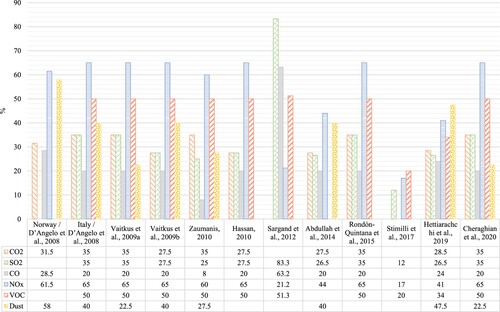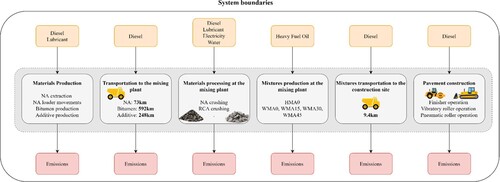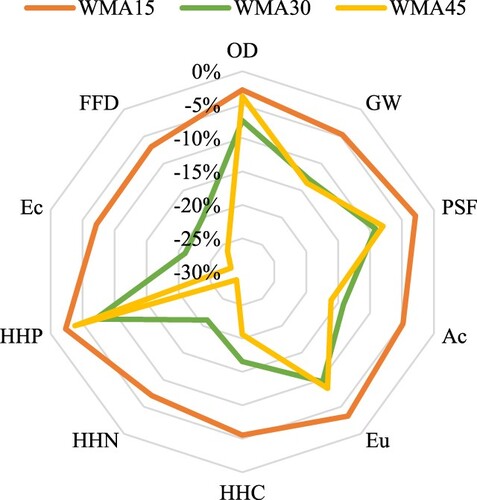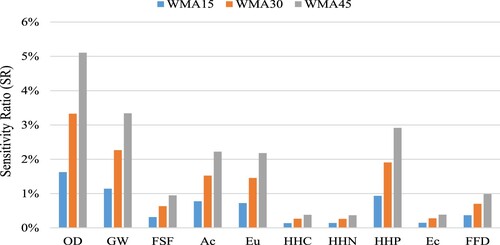 ?Mathematical formulae have been encoded as MathML and are displayed in this HTML version using MathJax in order to improve their display. Uncheck the box to turn MathJax off. This feature requires Javascript. Click on a formula to zoom.
?Mathematical formulae have been encoded as MathML and are displayed in this HTML version using MathJax in order to improve their display. Uncheck the box to turn MathJax off. This feature requires Javascript. Click on a formula to zoom.ABSTRACT
A Life Cycle Assessment (LCA) was undertaken to compare the potential environmental impacts associated with the use of Recycled Concrete Aggregate (RCA) as a partial replacement of natural aggregates in the production of Warm Mix Asphalt (WMA), with those of a conventional Hot Mix Asphalt (HMA). The LCA was conducted according to the ‘cradle-to-laid’ approach, including four pavement LCA phases. Three percentages of RCA replacement for natural coarse aggregates in WMA were considered: 15, 30 and 45%. The results of laboratory tests were used as inputs in the design of pavement structures with different percentages of RCA for typical Colombian pavement design conditions. Primary data and SimaPro 8.4.0 software were used in modelling the processes analysed in the case study. All the life cycle inputs and outputs related to the functional unit were characterised according to the impact assessment methodology TRACI v.2.1. The results show that the potential environmental benefits arising from the combined effect of reducing the consumption of natural aggregates and reduced mixing temperature are offset by the reduced performance and the increased optimum asphalt content when incorporating RCA in WMA. The highest relative increase in the environmental impacts, at 29%, was observed in the Ecotoxicity impact category.
1. Introduction
As the global awareness of the negative effects of climate change grows, the societal scrutiny and pressure placed on the most energy-intensive, raw-material-demanding and polluting industries can no longer be ignored. Among these, the road pavement construction industry is often in the spotlight owing to the nature of the processes involved as well as the magnitude of the quantity of paving materials consumed annually worldwide (EAPA Citation2010).
The production of Hot Mix Asphalt (HMA) requires high temperatures (150–190°C) to dry the aggregates and reduce the asphalt binder viscosity to ensure a proper aggregate coating during the mixing process (Rubio et al. Citation2012). These processes inevitably consume considerable quantities of energy and are responsible for equally staggering quantities of pollutants and greenhouse gases (GHGs). It is therefore clear that a cleaner approach to the production of asphalt mixtures requires a reduction in the processing and mixing temperatures (Shanbara et al. Citation2021).
Within this context, the academic and industrial communities have devoted considerable efforts and economic resources to developing and testing possible solutions to lower the production temperature for asphalt mixtures. From these endeavours, three main approaches to asphalt mixture production with manufacturing temperatures below those of conventional HMA have been established: (a) Cold Mix Asphalt (CMA), produced at temperatures lower than 60°C; (b) Half-Warm Mix Asphalt (HWMA), produced at temperatures between 60°C and 100°C; and (c) Warm Mix Asphalt (WMA), produced at temperatures in the 100°C to 140°C range (Toraldo et al. Citation2014). Among these new technologies, WMA has received particular attention due to its potential to considerably reduce both mixing and placement temperatures while providing an asphalt material with similar performance to that of conventional HMA (Vidal et al. Citation2013, Vega A. et al. Citation2019). Furthermore, all these options are also associated with reduced emissions of multiple pollutants and GHGs compared to those generated by the production of conventional HMA (). The most commonly applied technologies to achieve a reduction in mixing temperature involve the use of organic additives, chemical additives, foaming processes with water or foaming processes with natural or synthetic additives (EAPA Citation2010, Rubio et al. Citation2012).
Another growing practice aimed at achieving a more sustainable road infrastructure is the incorporation of recycled materials and by-products in asphalt mixtures, such as recycled asphalt pavement (RAP), steel slag, recycled concrete aggregates (RCA), recycled plastics and crumb rubber (Castro et al. Citation2019, Martinez-Arguelles et al. Citation2019b, Bressi et al. Citation2019, Nizamuddin et al. Citation2021, Santos et al. Citation2021, Santos et al. Citation2022). Of these, RAP is one of the most studied and used materials when trying to reduce the use of virgin aggregates in the production of both bound and unbound layers (Xiao et al. Citation2016, Farooq et al. Citation2018). The use of the other recycled materials in the production of HMA and WMA is to some extent constrained by a need for additional research ( Vega A. et al. Citation2022).
That is indeed the situation when it comes to the use of RCA in the production of WMA. In essence, RCA is the product of crushing old concrete from sidewalks, pavements, curbing and building slabs into smaller pieces that can subsequently be included in the aggregate fraction of precast concrete elements, granular road layers, as well as replacing virgin aggregates in HMA production (Pérez et al. Citation2010). According to Al-Bayati et al. (Citation2018) and Zhang et al. (Citation2016), RCA has certain properties that can influence, either negatively or beneficially, the performance of a cement or asphalt mix. In practical terms, RCA differs from natural aggregates because it retains a cement paste on their surface after the crushing process. The characteristic presence of this cement layer (adhered mortar) influences several RCA properties. For example, due to the high porosity of this mortar layer, RCA exhibits a lower bulk specific gravity and a higher absorption capacity. In addition, in the Los Angeles (LA) abrasion test, the Aggregate Crushing Value (ACV) of this type of aggregate have ranged from fair to very good (Pasandín and Pérez Citation2015, Martinez-Arguelles et al. Citation2019b).
Research studies on the mechanical performance of HMA have shown a fair to good performance when natural aggregates are replaced by RCA (Mills-Beale and You Citation2010, Zulkati et al. Citation2013). Here, the particular properties of the included RCA influence the mechanical and volumetric properties of the HMA (Zhang et al. Citation2016). For instance, including RCA was found to alter the HMA resistance to moisture damage with replacement rates above 75% of the total mass of aggregates (Mills-Beale and You Citation2010). Thus, for HMA, it seems clear that the included percentage and the properties of the RCA influence the behaviour of the mixture (Pasandín and Pérez Citation2015).
Turning to WMA, although the literature reports promising results in terms of laboratory and early field performance, there remain some concerns that underline the need for further research on several aspects including moisture susceptibility, rutting, long-term performance and cost effectiveness (Rubio et al. Citation2012). In terms of research efforts analysing the combined performance of WMA technologies and recycled materials, the most studied material has been RAP (Cheraghian et al. Citation2020, Guo et al. Citation2020), while little is known about the laboratory performance of WMA incorporating RCA. Furthermore, in one of the few papers specifically devoted to the performance of WMA incorporating RCA, Martinho et al. (Citation2018) concluded that generalising laboratory results for HMA incorporating RCA to the WMA counterpart might well be misleading due to the latter’s higher sensitivity to water as well as to the weaker rutting performance identified for some WMA mixes depending on the chemical additives used.
From an environmental standpoint, the Life Cycle Assessment (LCA) methodology has been frequently used to estimate the environmental impacts of roads and pavement materials (Balaguera et al. Citation2018, Jiang and Wu Citation2019, Hoxha et al. Citation2021) since it provides a systematic approach that allows the potential environmental impacts generated by a product, process or system throughout its life cycle to be evaluated (ISO 14040 Citation2007).
The environmental impacts related to the use of RAP in pavements has been widely reported (Shi et al. Citation2018, Hasan et al. Citation2020, Vandewalle et al. Citation2020). This contrasts with the much more limited study of the environmental impacts of RCA (Ma et al. Citation2019). Nevertheless, this can be broken down into three categories: (a) RCA production as aggregate (Marinković et al. Citation2010, Rosado et al. Citation2017, Martinez-Arguelles et al. Citation2019b); (b) RCA applications in HMA (Tahmoorian et al. Citation2019, Vega A. et al. Citation2022); and (c) RCA applications in Portland Cement Concrete (PCC) mixes (Colangelo et al. Citation2018, Shi et al. Citation2019). In general, RCA has shown very promising and positive results in terms of environmental impacts when used as a natural aggregate replacement. However, such environmental benefits should be evaluated while considering the optimum RCA content and the influence of physical and chemical properties in the mixture’s performance.
Several studies have assessed the environmental performance of WMA technologies (Jamshidi et al. Citation2018, Ma et al. Citation2019, Hasan et al. Citation2020). Some show energy savings and reduced environmental impacts due to the use of WMA, while others found that there are considerable variations among the different WMA technologies, and that the reduced impacts resulting from the lower mixing temperature might be offset by the greater impacts related to the use of additives (Cao et al. Citation2019). Furthermore, to the best of the authors’ knowledge, no studies have assessed the environmental performance of WMA with RCA as an aggregate replacement.
In order to fill this research gap, the research work presented in this paper aims to compare the potential environmental impacts associated with the use of RCA, as a partial substitute for natural aggregates in the production of WMA, with those of a conventional HMA through an LCA study based on laboratory tests and mixture design calculations.
2. Methodology
2.1. Life cycle assessment
A comparative attributional process-based LCA was performed following as far as possible the International Organization for Standardization (ISO) guidelines for LCA (ISO Citation2006) and the Federal Highway Administration’s (FHWA’s) Pavement LCA framework (Harvey et al. Citation2016).
2.1.1. Goal and scope definition
The main goal of this study was to estimate and compare the potential environmental impacts linked to the production of WMA, containing different percentages of RCA as substitutes for coarse natural aggregates (NA), with those of the conventional HMA (i.e. with no RCA content). Specifically, four percentages of RCA replacements were considered: 0, 15, 30 and 45%. These percentages were selected based on a comprehensive laboratory study previously carried out by the authors. Further, these percentages reflect findings in the literature, where the optimal replacement percentages in HMA were found to be between 10% and 50%. (Paranavithana and Mohajerani Citation2006, Mills-Beale and You Citation2010, Pasandín and Pérez Citation2014). The results are intended to be useful for highway agencies and pavement practitioners striving to deliver more sustainable road pavement infrastructures.
2.1.1.1. System description and boundaries
The LCA was conducted according to a ‘cradle-to-laid’ approach. The system boundaries are presented in . They include four pavement life cycle phases: i) material production and transportation to the mixing plant; ii) material processing and mixture production at the mixing plant; iii) mixture transportation to the construction site; and iv) pavement construction. Furthermore, the boundaries for the pavement structure were limited to the binder course (BC). presents the main processes considered in the LCA study in each phase.
Table 1. Processes considered in the LCA study per pavement life cycle phase.
Furthermore, a ‘cut-off’ allocation approach was adopted for dealing with the RCA (Schrijvers et al. Citation2016, Santos et al. Citation2018a). Thus, only the impacts associated with the processing of RCA to transform it into suitable material for asphalt mixture applications were attributed to the system receiving the recycled materials. In other words, the environmental burdens related to the pavement demolition and the transportation of the demolition materials to the recycling facility were considered to be outside the system boundaries.
2.1.1.2. Functional unit
The establishment of a functional unit forms the basis for comparing different products with the same utility for the same function. In the pavement domain, this means a pavement structure that can safely and efficiently support the same volume of traffic over the same project analysis period. As such, it is defined by its geometry, service life and level of traffic supported. In this study, the functional unit was defined as the binder course (BC) of a typical Colombian highway section of 1 km in length with one lane 3.5 m wide. Based on the goal and scope of the investigation, the remaining pavement layers were not included in the system boundaries and were assumed to have the same thickness regardless of the asphalt mixture used.
The pavement structures were designed according to the conventional characteristics of traffic and subgrade support in Barranquilla, Colombia. Specifically, as recommended by INVIAS (Citation2008), they were designed for a traffic volume of 5×106 Equivalent Single Axle Loads (ESAL) of 80kN, a California Bearing Ratio (CBR) of 7.5% and a common service life of 10 years. The thicknesses of the layers making up a pavement structure designed for a conventional HMA (i.e. 0% RCA content) are illustrated in .
Figure 3. Thickness of the layers composing a pavement structure designed with a conventional HMA. Acronyms: SC- Surface Course; BC- Binder Course; GB – Granular Base; GSB – Granular Sub-Base.
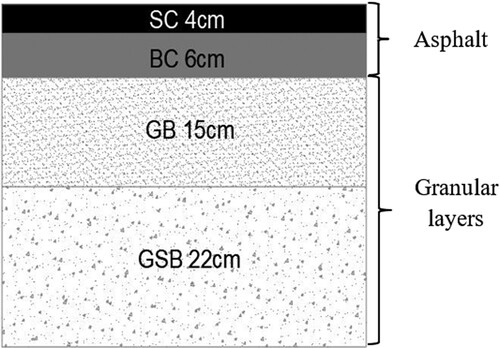
In order to ascertain the potential environmental advantages of using WMA, with and without an RCA content, in the BC, the reference pavement structure () was compared with four structures of similar geometry, but in which the BC was made of WMA with four levels of RCA content. The considered alternatives represent structures with equivalent structural capacity, achieved by changing only the thickness of the asphalt BC. Therefore, the surface course (SC) is a conventional mixture and the granular layers (GB and GSB) correspond to those commonly used in the region of Barranquilla for asphalt pavements that satisfy Colombian standards (INVIAS Citation2014a). Laboratory tests were carried out to determine the proportions of the mixture components and their performance.
presents the composition and characteristics of the mixtures analysed in the case study. A key in the form ‘XY’ was adopted to identify the various mixtures. Here, ‘X’ stands for the type of mixture (i.e. WMA or HMA) and ‘Y’ the percentage of RCA (i.e. 0, 15, 30 or 45%). In addition, the aggregates component of all mixtures is made up of 50% coarse aggregates and 50% fine aggregates. The RCA replacements were only included in the coarse aggregate fraction corresponding to 50% of the total mass of the aggregates.
Table 2. Composition and characteristics of the mixtures.
The mixture designs followed the Marshall design specifications, which are the country’s official mix design method (INVIAS Citation2013) and all samples satisfied the Colombian standards for road materials (INVIAS Citation2014b). To assess the mixtures’ performance, resilient modulus tests were performed according to EN 12697–26 (C). The results presented in are from tests carried out at 40°C and 4 Hz.
In designing the pavement structures, the CEDEM tool (Reyes and Delgado, Citation1998) was adopted taking into account the characteristics and mechanical performance of the various mixtures and following standard practice in Colombia. The pavement design process was conducted using a rational design approach procedure in which two criteria are considered to mainly determine rutting and fatigue performance: 1) a maximum limit on the vertical pressure on the subgrade; and 2) a maximum limit on horizontal tensile strain at the bottom of the layers for the corresponding design ESAL. A multi-layered elastic theory was used to model the pavement structure and calculate the stresses and strains under the loading of the legal axle weight as shown in . These maximum critical stresses and strains values were then compared with the corresponding admissible threshold values calculated according to the Shell pavement design method (Equations (1) to (4)) to confirm that rutting and cracking requirements were satisfied. shows the input data for the pavement design for each mixture. The designs are presented in , and the corresponding stress and strain levels are shown in .
(1)
(1)
(2)
(2)
(3)
(3)
(4)
(4) where
is the admissible vertical stress in the subgrade, CBR is the California Bearing Ratio of the subgrade, N is the design traffic in accumulated equivalent axles in the design lane,
is the admissible vertical deformation in the subgrade,
is the admissible radial deformation at the base of the asphalt layers and
is the admissible vertical deflection.
Figure 4. Schematic representation of the pavement design in Colombia (INVIAS Citation2008). Acronyms: P – equivalent axle weight; D- distance between wheels; A- contact area radius; q- contact pressure.
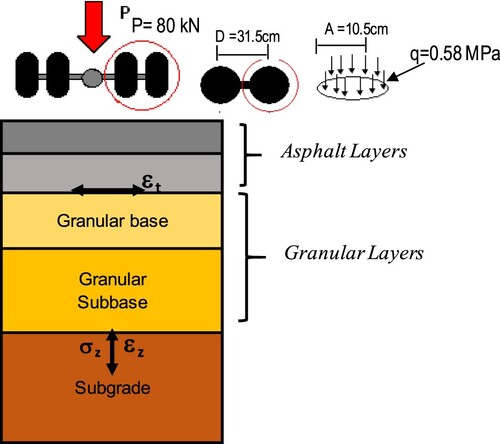
Table 3. Pavement design input data for each mixture.
Table 4. Stress and strain levels for each mixture.
2.1.2. Life cycle inventory (LCI)
In this LCA phase, all the data used for the analysis are defined in such a way that the primary and secondary data for each evaluated process and their corresponding sources are specified (ISO 14040 Citation2007, Santos et al. Citation2018a). Primary data are those specific to the production processes related to the product or service studied in the LCA. In turn, secondary data represent generic or average data for the product or service subject to analysis (European Commission Citation2010, Santos et al. Citation2018b). In this study the data sources were selected to be as much time, geographic and technologically representative as possible. Primary data were assembled from surveys and laboratory tests. Specifically, four asphalt mixing plants were examined, and relevant data collected. In turn, the secondary data were obtained from databases and literature but modified wherever possible and appropriate to better approximate Colombian conditions and practices.
More specifically, existing research studies plus Ecoinvent v.3 and USLCI databases were used as sources of secondary data. and present respectively the sources of primary and secondary data for each process. presents the sources and values of the data for each pavement life cycle phase and the main processes. These data were combined with information about asphalt mixture design, aggregate properties and mechanical performance obtained from specific tests performed in the laboratory. Further details on the modelling of the processes related to the pavement life cycle phases and respective data sources are provided in the subsections below.
Table 5. Primary data sources by process.
Table 6. Secondary data sources per process.
Table 7. LCI data considered in the case study.
2.1.2.1. Materials production and transportation to the mixing plant phase
In this pavement LCA phase we account for the environmental impacts related to the production of the raw materials as well as their transportation to the mixing plant. This phase covers all the processes required to extract the raw materials through to arrival at the mixing plant. Thus, it considers the following processes: i) natural aggregate extraction, ii) natural aggregate loading into dump trucks, iii) bitumen production, iv) additive production, and v) transportation of raw materials to the mixing plant.
2.1.2.1.1. Materials production sub-phase
As explained above, each mixture type contains 50% coarse aggregates and 50% fine aggregates. Here, the natural aggregates required for the case study were modelled as gravel and sand. The LCI data related to their extraction were obtained from a previous investigation carried out with the objective of producing an LCA of the production of natural aggregates and RCA (Martinez-Arguelles et al. Citation2019a). Bitumen production was modelled according to ‘bitumen, at refinery/kg/US’ process from the USLCI database. Additive production was modelled in line with the ‘fatty acid/market for/Alloc Def, U’ process in the Ecoinvent database. Finally, for modelling the process of loading the natural aggregates into dump trucks, information obtained from surveys was used.
2.1.2.1.2. Materials transportation to the mixing plant sub-phase
This sub-phase accounts for the impacts related to the transportation of materials to the mixing plant. The LCI data related to this sub-phase were obtained from surveys and based on realistic distances for the case study scenario ().
2.1.2.2. Material processing and mixture production at the mixing plant phase
Here, the environmental impacts associated with the manufacturing processes required to transform the raw materials into an asphalt mixture were determined. It includes the environmental burdens related to: i) natural aggregate processing, ii) RCA processing, iii) hauling the aggregates (natural and recycled) from stockpiles to the feed bins, and iv) mixture production.
2.1.2.2.1. Material processing sub-phase
This sub-phase includes the environmental impacts associated with the further processing of the aggregates and their movement within the asphalt plant facility. Here, LCI data were obtained from an earlier broad research project (Martinez-Arguelles et al. Citation2019a) that covered many aspects of the research study presented in this paper. As such, the inventory data taken from the previous research study are labelled as primary data in the present study.
2.1.2.2.2. Mixture production sub-phase
This sub-phase considers the impacts that arise from the production of the different types of mixtures assessed in this case study. A thermodynamic relationship (Equation 5) was used to calculate the thermal energy (TE) provided by burning heavy fuel oil (HFO) to produce each mixture. This input was determined according to the energy balance proposed by Santos et al. (Citation2018a) using the values presented in .
Table 8. Parameters considered to calculate thermal energy according to Equation 5.
The CL parameter presented in represents the TE used to heat the metal plant and later lost to the atmosphere (West et al. Citation2014). This was considered to be the same for all mixtures with data taken from the literature (Santos et al. Citation2018a). The other parameters were also considered to remain constant for all the mixtures studied.
(5)
(5) where TE is the thermal energy (MJ/tonne mixture) required to produce the asphalt mixture, M is the total quantities of aggregates fractions, mi is mass of aggregates of fraction i, Ci is the specific heat of aggregates of fraction i. The remaining parameters are described in .
The quantity of TE expressed in MJ/tonne mixture and the corresponding Fuel Consumption (FC) expressed in kg of HFO/tonne mixture are shown in . Furthermore, this table also contains the Reduction Factor (RF) values associated with each type of mixture. This represents the reduction in TE for each alternative mixture and the basic control one (i.e. HMA0).
Table 9. Thermal Energy (TE) consumed for producing each mixture and Reduction Factor (RF).
2.1.2.3. Mixtures transportation to the construction site phase
In this phase, the environmental impacts related to transporting the mixtures from the asphalt plant to the construction site were analysed. Here, the density of the mixtures, obtained from laboratory tests, and truck fuel consumption data, obtained from surveys, were taken into consideration. Again, the transportation distances presented in were used.
2.1.2.4. Pavement construction phase
The environmental burdens generated during the pavement construction activities were analysed in this phase. The LCI data associated with the equipment used in the case study (i.e. finisher, vibratory and pneumatic rollers) are presented in , and .
2.1.3. Life cycle impact assessment (LCIA)
The LCI results were classified and characterised according to the characterisation factors defined by the Tool for Reduction and Assessment of Chemicals and Other Environmental Impacts (TRACI) v.2.1. impact assessment methodology (Bare Citation2012). It assesses the potential environmental impacts in ten impact categories: 1) ozone depletion (OD), 2) global warming (GW), 3) photochemical smog formation (PSF), 4) acidification (Ac), 5) eutrophication (Eu), 6) human health – cancerous (HHC), 7) human health – noncancerous (HHN), 8) human health – particulate (HHP), 9) ecotoxicity (Ec) and 10) fossil fuel depletion (FFD). These impact categories estimate the potential damage to: (1) human health; (2) ecosystem diversity; and (3) resource availability (Sharaai et al. Citation2010, Zgola et al. Citation2014). Further, the optional LCIA steps (i.e. normalisation, group and weighting) established in the ISO 14040 standards were not considered (ISO 14040 Citation2007). Simapro software version 8.4.0 was used for modelling the processes analysed in this case study (PRé Consultants Citation2014).
3. Results and discussion
3.1. Full life cycle impact assessment results
Based on the LCA methodology and assumptions described above the potential ‘cradle-to-laid’ environmental impacts were calculated. summarises the LCIA results for the conventional mixture (HMA0) and for WMA with different percentages of RCA substitution. illustrates the relative variations in the various life cycle environmental impact scores for each alternative mixture in relation to those associated with the conventional mixture. The relative values should be understood as follows: positive relative percentages mean that the use of WMA mixed with RCA improves the LCIA results in relation to those associated with HMA0. Conversely, negative percentages represent a worsening of the environmental profile.
Figure 6. Relative variations in the LCIA results for each binder-course mixture relative to the baseline mixture (HMA0).
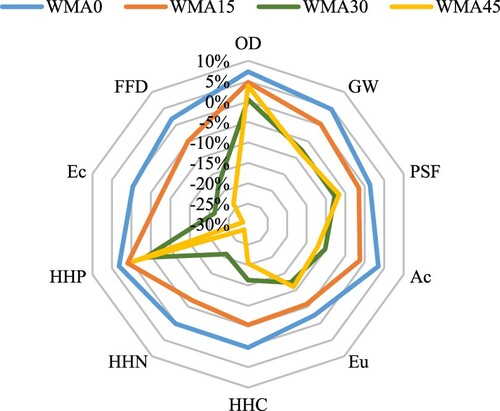
Table 10. LCIA results per mixture applied in the binder course considered in the case study. The thickness of the binder course is also included to facilitate the interpretation of the results.
The results presented show that, overall, the use of WMA with an RCA component has a detrimental effect on the environmental profile of the BC with respect to the control mixture (HMA0). The increase in the impact category scores can be as high as 29% for the Ecotoxicity impact category with the WMA45 mixture. WMA15, with the smallest RCA component, only offers environmental benefits in three impact categories, namely Ozone depletion, Global warming and Human health – particulate, while WMA30 and WMA45 only provide a better environmental performance in the Ozone depletion category. However, WMA0, with no RCA component, does offer benefits in eight of the ten impact categories (the exceptions being Eutrophication and Ecotoxicity).
Thus overall, and perhaps intuitively unexpected, increasing the RCA percentage in the WMA mixture increases the environmental impact in most categories relative to the conventional mixture. Based on the conditions applied in this case study, this is largely attributable to two factors. First, the WMA mixtures with RCA were found to have a lower performance than that of the conventional HMA0, and therefore require thicker BC layers to achieve an equivalent performance. Specifically, the WMA15, WMA30 and WMA45 mixtures require BC layers that were 8, 17 and 17% thicker respectively than the HMA0 baseline. Second, the use of RCA was found to lead to an increase in the optimum asphalt content. In the mixtures without RCA, the optimum asphalt content was 4.4%, but this increased to 5.2% in the WMA45 mixture. This increase was a consequence of the mortar layer covering the RCA particles (from its previous use) being more porous and less dense than the underlying natural aggregates, and being relatively weakly bonded to them, which negatively affect the RCA properties (Paranavithana and Mohajerani Citation2006, Tahmoorian and Samali Citation2018).
3.2. Contribution analysis
shows the relative contribution of the several processes to the total environmental impact scores. From the analysis of this figure, it can be seen that the environmental profile of the mixtures is largely driven by three processes, namely Bitumen production, Mixtures production and Natural aggregates extraction, although their relative position varies across the impact categories. Bitumen production is particularly relevant to the Human health – noncancerous, Ecotoxicity and Fossil fuel depletion impact categories. For example, bitumen production contributes 90, 88 and 80% of the total impact to these categories with the WMA45 mixture although it should be noted that this process makes major contributions with all the mixtures including the baseline HMA0. Mixture production is the major contributor to the scores in the Ozone depletion, Global warming and Human health – particulate impact categories, contributing 47, 34 and 28% respectively with the HMA0 mixture. Finally, the Natural aggregates extraction process is the main contributor to the Human health – particulate, Photochemical smog formation and Eutrophication impact categories, accounting for 49, 45 and 38% respectively of the total scores of the WMA0 mixture. Reassuringly, the results displayed in are consistent with results reported in the literature, where contributions of up to 90% are observed from the production of bitumen (Vidal et al. Citation2013), close to 30% for the production of the mixture (Ma et al. Citation2019) and around 25% for the extraction of natural aggregates (Santos et al. Citation2018a).
Figure 7. Relative contribution of the main processes to the total life cycle impact assessment scores: (a) OD; (b) GW; (c) PSF; (d) Ac; (e) Eu; (f) HHC; (g) HHN; (h) HHP; (i) Ec; and (j) FFD.

In comparison, the contributions of the Mixture transportation, RCA crushing and Natural aggregates loader movement processes were found to be almost negligible compared to the processes discussed above. For instance, the Mixture transportation process contributes less than 0.3% to most of the impact categories, while the Natural aggregates loader movement processes’ largest contribution is less than 3% to Photochemical smog formation. Finally, the Additive production process’s maximum contribution is 7% in the Eutrophication impact category with the WMA45 mixture.
As the RCA content in the mixture increases, the relative impact of Natural aggregates extraction process naturally decreases up to a maximum of 13% in the relative contributions of this process to the various impact categories when comparing WMA45 and HMA0. Similarly, when comparing the relative contributions of the Natural aggregates extraction and RCA crushing processes, the former can contribute up to 47% of the Human health – particulate impact category score (for WMA15), whereas the RCA processing for WMA45 contributes less than 2% to the score of this impact category.
Furthermore, when comparing the HMA0 and WMA0 mixtures, reductions of up to 4% are obtained in the relative contributions of the Mixture production process to the Ozone depletion, Global warming, Eutrophication and Human health – particulate impact category scores. Similar reductions in the relative contribution of this process are observed in the Global warming, Acidification and Fossil fuel depletion impact categories when comparing HMA0 and WMA45.
3.3. Environmental consequences of incorporating RCA in WMA
To focus on the environmental effects of including RCA in WMA, shows the relative variations in the impact scores for each WMA mixture with RCA relative to those for WMA0 (with no RCA). Positive values indicate that the alternative mixtures (WMA with RCA content) improve the LCIA indicators relative to the control mixture (WMA0), while negative relative numbers can be interpreted as a deterioration of the environmental profile of the WMA alternatives over WMA0.
From these results, it can be concluded that the hypothetical environmental savings from reducing the consumption of natural aggregates by using RCA in the WMA mixture are more than offset by the additional emissions generated by the required increase in the thickness of the BC layer and the increased asphalt and additive contents. For example, the WMA15, WMA30 and WMA45 binder course layers are calculated to increase the Human health – noncancerous impact category score by 7, 21 and 29% over that of WMA0.
3.4. Sensitivity analysis
A sensitivity analysis was carried out to evaluate the sensitivity of the results to changes in the value of an influential parameter. The choice between the parameters was driven by their hypothetical relevance in a realistic process and the uncertainties attached to the values. Based on these criteria, it was decided to analyse the influence of the RCA’s moisture content. This was selected because, first, the RCA aggregates are commonly stockpiled in unsheltered conditions, which is particularly relevant in the Colombian context given the high rainfall. Second, the production of RCA involves the use of water and recent studies have found that the energy consumed in the production of asphalt mixtures is significantly influenced by the moisture content of the mineral mixture (Androjić et al. Citation2020).
In the analysis, the moisture content was changed, in increments of 0.5%, up to a maximum value of 8% (Federal Highway Administration Research and Technology Citation2016) and the impact on the results was evaluated using a sensitivity ratio (SR) (Clavreul et al. Citation2012). SR is calculated, using Equation 6, as the ratio of the relative change in the impact assessment result divided by the relative change in the parameter value. The higher the ratio value, the greater the impact that a change in the parameter has on the results.
(6)
(6) shows the results of the sensitivity analysis obtained when the moisture content value is set at 8% relative to the baseline 3%. From this figure, it can be concluded that the Ozone depletion, Global warming and Human health – particulate impact categories are most affected by changes in the RCA’s moisture content. The Human health – cancerous, Human health – noncancerous and Ecotoxicity impact categories are least impacted by changes in this parameter. Finally, as one would expect since the energy consumed in the production of the asphalt mixtures is considerably influenced by the moisture content of the aggregate fractions, the higher the RCA content in the WMA, the greater the impact of the change in moisture content on the environmental impact scores.
3.5. Comparison of the results with the literature
In this section, the results obtained from the case study are benchmarked against those reported in some of the existing literature on the LCA of so-called eco-friendly asphalt mixture technologies (). Here, only studies that provided numerical LCIA results are considered. The comparison focuses on the Global Warming impact category since it is the impact category that is common to all studies reported in the literature and receives most attention from academics and industrial members. Further, the scores are presented per cubic metre of mixture rather than by weight because not all studies report the densities of the mixtures considered.
Figure 10. Global warming scores of the various mixtures considered in this study compared to those reported in the existing literature on LCAs of so-called eco-friendly asphalt mixture technologies.
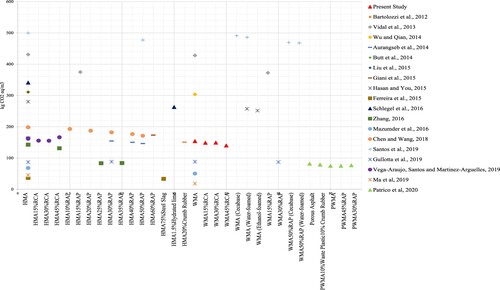
As can be seen from , the results of the case study presented in this paper are well within the ranges reported elsewhere. This gives confidence that the findings from this case study are plausible given the differences in the system boundaries, data, assumptions and the geographical and technical contexts of the various studies.
4. Summary and conclusions
In this paper, the results of a process-based LCA study related to the construction of the binder course of a typical Colombian road pavement section using WMA, with and without RCA, were compared with those of a conventional asphalt binder mixture (i.e. HMA without RCA). In order to evaluate the potential environmental effects of using RCA as a substitute for coarse natural aggregates in WMA, an LCA study was carried out according to a ‘cradle-to-laid’ approach. The life cycle of the road pavement was divided into four main phases: (1) material production and transportation to the mixing plant; (2) material processing and mixture production at the mixing plant; (3) mixture transportation to the construction site; and (4) pavement construction. Primary data collected from Colombian contractors in the region of Barranquilla and laboratory test results were used as LCI input. Three proportions (15, 30 and 45%) of RCA as an alternative to coarse natural aggregates were considered in the design of the asphalt binder layer of the pavement structure. The case study used the SimaPro v.8.4.0. modelling tool and the TRACI v.2.1 impact assessment method to model and characterise the environmental performance of the road pavement section.
Based on the conditions considered in the case study, the following conclusions can be drawn:
the potential environmental benefits arising from the combined effect of reducing the consumption of natural aggregates and a lower mixing temperature are more than offset by the lower performance and the consequent need for greater asphalt content in WMA incorporating RCA;
the increase in the impact category scores can be as high as 29% for the Ecotoxicity impact category when considering WMA45;
compared to the baseline mixture (HMA0), the WMA15 mixture offers improved environmental benefits in only three impact categories, Ozone depletion, Global warming and Human health – particulate, but with savings of only up to approximately 5%;
compared to HMA0, the WMA30 and WMA45 mixtures exhibit a better environmental performance only in the Ozone depletion impact category, with reductions of up to 4%;
the environmental profile of the various mixtures is largely driven by the Bitumen production, Mixture production and Natural aggregates extraction processes;
as the RCA content in the mixture increases, greater reductions are obtained in the environmental impacts of the Natural aggregates extraction and Mixture production processes;
a reduction of about 10% in the contribution of the Natural aggregates extraction process to the Photochemical smog formation impact category can be obtained by using WMA45 compared to HMA0;
reductions of about 4% in the contributions of the Mixture production process to the Global warming, Acidification and Fossil fuel depletion impact categories can be obtained by using WMA45 compared to HMA0;
Bitumen production has a particularly strong influence on the Human health – noncancerous, Ecotoxicity and Fossil fuel depletion impact categories, contributing between 80 and 90% of the total environmental impact scores with the WMA45 mixture;
the contributions of the Mixture transportation, RCA crushing and Natural aggregates loader movement processes environmental impact scores were negligible;
the Ozone depletion, Global warming and Human Health Particulate impact categories are particularly affected by changes in the moisture content of the RCA;
the results of the case study presented in this paper are well within the ranges reported in the literature on the LCA of so-called eco-friendly asphalt mixture technologies.
Finally, the methodology, inventory and results described in this paper can be used as a reference to undertake LCA studies in countries with similar socioeconomic levels, weather conditions and technical contexts as those observed in Colombia.
Disclosure statement
No potential conflict of interest was reported by the author(s).
Additional information
Funding
References
- Androjić, I., et al., 2020. Analysis of impact of aggregate moisture content on energy demand during the production of hot mix asphalt (HMA). Journal of Cleaner Production, 244. doi:10.1016/j.jclepro.2019.118868.
- Al-Bayati, H.K.A., Tighe, S.L., and Achebe, J., 2018. Influence of recycled concrete aggregate on volumetric properties of hot mix asphalt. Resources Conservation and Recycling, 130, 200–214. doi:10.1016/j.resconrec.2017.11.027
- Balaguera, A., et al., 2018. Life cycle assessment of road construction alternative materials: a literature review. Resources, Conservation and Recycling, doi:10.1016/j.resconrec.2018.01.003.
- Bare, J, 2012. Tool for the Reduction and Assessment of Chemical and O ther Environmental Impacts (TRACI), Version 2.1 – User’s Manual. EPA/600/R-12/554.
- Bressi, S., et al., 2019. A comparative environmental impact analysis of asphalt mixtures containing crumb rubber and reclaimed asphalt pavement using life cycle assessment. International Journal of Pavement Engineering, doi:10.1080/10298436.2019.1623404.
- Cao, R., et al., 2019. Comparative life cycle assessment of warm mix technologies in asphalt rubber pavements with uncertainty analysis. Resources, Conservation and Recycling, doi:10.1016/j.resconrec.2019.04.031.
- Castro, A., et al., 2019. Mechanical properties of Cold recycled Bituminous mixes with crumb rubber. IOP Conference Series: Materials Science and Engineering, 471, 102044. doi:10.1088/1757-899X/471/10/102044.
- Cheraghian, G., et al., 2020. Warm mix asphalt technology: an up to date review. Journal of Cleaner Production, 268, 122128. doi:10.1016/j.jclepro.2020.122128.
- Clavreul, J., Guyonnet, D., and Christensen, T.H, 2012. Quantifying uncertainty in LCA-modelling of waste management systems. Waste Management, 32, 2482–2495. doi:10.1016/j.wasman.2012.07.008.
- Colangelo, F., et al., 2018. Life cycle assessment of recycled concretes : a case study in southern Italy. Science of The Total Environment, 615, 1506–1517. doi:10.1016/j.scitotenv.2017.09.107.
- EAPA, 2010. The Use of Warm Mix Asphalt. Draft EAPA Position Pap.
- European Commission – Joint Research Centre – Institute for Environment and Sustainability, 2010. International Reference Life Cycle Data System (ILCD) Handbook – General guide for Life Cycle Assessment – Detailed guidance, Constraints.
- Farooq, M.A., Mir, M.S., and Sharma, A, 2018. Laboratory study on use of RAP in WMA pavements using rejuvenator. Construction and Building Materials, 168, 61–72. doi:10.1016/j.conbuildmat.2018.02.079.
- Federal Highway Administration Research and Technology, 2016. User Guidelines for Waste and Byproduct Materials in Pavement Construction [WWW Document].
- Guo, M., et al., 2020. Effect of WMA-RAP technology on pavement performance of asphalt mixture: a state-of-the-art review. Journal of Cleaner Production, 266, 121704. doi:10.1016/j.jclepro.2020.121704.
- Harvey, J.T., et al., 2016. Pavement Life Cycle Assessment Framework. (No. FHWA-HIF-16-014). United States. Federal Highway Administration.
- Hasan, U., Whyte, A., and Al, H, 2020. Life cycle assessment of roadworks in United Arab Emirates : recycled construction waste, reclaimed asphalt pavement, warm-mix asphalt and blast furnace slag use against traditional approach. Journal of Cleaner Production, 257, 120531. doi:10.1016/j.jclepro.2020.120531.
- Hoxha, E., et al., 2021. Life cycle assessment of roads : exploring research trends and harmonization challenges. Science of The Total Environment, 759, 143506. doi:10.1016/j.scitotenv.2020.143506.
- INVIAS, 2013. Secciones 700 y 800 – Materiales y mezclas asfálticas y prospección de pavimentos (Primera parte).
- INVIAS, 2014a. CAPÍTULO 3 - AFIRMADOS, SUBBASES Y BASES.
- INVIAS, 2014b. Capítulo 4 – Pavimentos Asfálticos.
- INVIAS, I.N. de V., 2008. Guía Metodológica para el Diseño de obras de rehabilitación de pavimentos asfálticos de carreteras, Segunda ed. ed. Bogotá D. C.
- ISO 14040, 2007. Environment management- Life cycle assessment- Principles and framework.
- ISO, 2006. Environmental Management-Life Cycle Assessment-Requirements and Guidelines. 2009.
- Jamshidi, A., et al., 2018. Estimating correlations between rheological characteristics, engineering properties, and CO 2 emissions of warm-mix asphalt. Journal of Cleaner Production, 189, 635–646. doi:10.1016/j.jclepro.2018.04.087.
- Jiang, R., and Wu, P, 2019. Estimation of environmental impacts of roads through life cycle assessment : a critical review and future directions. Transportation Research Part D: Transport and Environment, 77, 148–163. doi:10.1016/j.trd.2019.10.010.
- Ma, H., et al., 2019. A Comparative Life Cycle Assessment (LCA) of Warm Mix Asphalt (WMA) and Hot Mix Asphalt (HMA) pavement : a case study in China. Advances in Civil Engineering, 2019. Article ID 9391857, 12
- Marinković, S., et al., 2010. Comparative environmental assessment of natural and recycled aggregate concrete. Waste Management, 30, 2255–2264. doi:10.1016/j.wasman.2010.04.012.
- Martinho, F.C.G., Picado-Santos, L.G., and y Capitão, S.D., 2018. Influence of recycled concrete and steel slag aggregates on warm-mix asphalt properties. Construction and Building Materials, 185, 684–696. doi:10.1016/j.conbuildmat.2018.07.041.
- Martinez-Arguelles, G., et al., 2019a. Life cycle assessment of natural and recycled concrete aggregate production for road pavements applications in the northern region of Colombia : case study. Transportation Research Record: Journal of the Transportation Research Board, 2673, 397–406.
- Martinez-Arguelles, G., et al., 2019b. Characterization of recycled concrete aggregate as potential replacement of natural aggregate in asphalt pavement. IOP Conference Series: Materials Science and Engineering, 471, 102045. doi:10.1088/1757-899X/471/10/102045.
- Mills-Beale, J., and You, Z, 2010. The mechanical properties of asphalt mixtures with recycled concrete aggregates. Construction and Building Materials, 24, 230–235. doi:10.1016/j.conbuildmat.2009.08.046.
- Nizamuddin, S., et al., 2021. Recycling of low-value packaging films in bitumen blends: a grey-based multi criteria decision making approach considering a set of laboratory performance and environmental impact indicators. Science of The Total Environment, 778, 146187. doi:10.1016/j.scitotenv.2021.146187.
- Paranavithana, S., and Mohajerani, A, 2006. Effects of recycled concrete aggregates on properties of asphalt concrete. Resources, Conservation and Recycling, 48, 1–12. doi:10.1016/j.resconrec.2005.12.009.
- Pasandín, A.R., and Pérez, I, 2014. Effect of ageing time on properties of hot-mix asphalt containing recycled concrete aggregates. Construction and Building Materials, 52, 284–293. doi:10.1016/j.conbuildmat.2013.11.050.
- Pasandín, A. R., and Pérez, I, 2015. Characterisation of recycled concrete aggregates when used in asphalt concrete: a technical literature review. European Journal of Environmental and Civil Engineering, 19, 917–930. doi:10.1080/19648189.2014.985850.
- Pérez, I., et al., 2010. Asphalt mixtures with construction and demolition debris. Proceedings of the Institution of Civil Engineers – Transport, 163, 165–174. doi:10.1680/tran.2010.163.1.1.
- PRé Consultants, 2014. SimaPro [WWW Document].
- Reyes, F., and Delgado, J, 1998. Programa CEDEM.
- Rosado, L.P., et al., 2017. Life cycle assessment of natural and mixed recycled aggregate production in Brazil. Journal of Cleaner Production, 151, 634–642. doi:10.1016/j.jclepro.2017.03.068.
- Rubio, M.C., et al., 2012. Warm Mix Asphalt: an overview. Journal of Cleaner Production, 24, 76–84. doi:10.1016/j.jclepro.2011.11.053.
- Santos, J., et al., 2018a. Life cycle assessment of low temperature asphalt mixtures for road pavement surfaces: a comparative analysis. Resources, Conservation and Recycling, 138, 283–297. doi:10.1016/j.resconrec.2018.07.012.
- Santos, J., et al., 2021. Recycling waste plastics in roads: a life-cycle assessment study using primary data. Science of The Total Environment, 751, 141842. doi:10.1016/j.scitotenv.2020.141842.
- Santos, J., Cerezo, V., Soudani, K., Bressi, S., 2018b. A Comparative Life Cycle Assessment of Hot mixes Asphalt Containing Bituminous binder modified with waste and virgin polymers, in: Procedia CIRP. Elsevier B.V., pp. 194–199. doi:10.1016/j.procir.2017.11.046
- Santos, J., Pizzol, M., Azarijafari, H., 2022. 14 – Life cycle assessment (LCA) of using recycled plastic waste in road pavements: theoretical modeling, in: Giustozzi, F., Nizamuddin, S.B.T.-P.W. for S.A.R. (Eds.), Woodhead Publishing Series in Civil and structural engineering. Woodhead Publishing, pp. 273–302. doi:10.1016/B978-0-323-85789-5.00014-9
- Schrijvers, D.L., Loubet, P., and Sonnemann, G, 2016. Critical review of guidelines against a systematic framework with regard to consistency on allocation procedures for recycling in LCA. The International Journal of Life Cycle Assessment, doi:10.1007/s11367-016-1069-x.
- Shanbara, H.K., et al., 2021. The future of eco-friendly cold mix asphalt. Renewable and Sustainable Energy Reviews, 149, 111318. doi:10.1016/j.rser.2021.111318.
- Sharaai, A.H., Mahmood, N.Z., and Healt, S, 2010. Life cycle impact assessment (LCIA) using TRACI methodology : an analysis of potential impact on potable water production. Australian Journal of Basic and Applied Sciences, 4, 4313–4322.
- Shi, X., et al., 2019. Economic input-output life cycle assessment of concrete pavement containing recycled concrete aggregate. Journal of Cleaner Production, 225, 414–425. doi:10.1016/j.jclepro.2019.03.288.
- Shi, X., Mukhopadhyay, A., and Zollinger, D, 2018. Sustainability assessment for portland cement concrete pavement containing reclaimed asphalt pavement aggregates. Journal of Cleaner Production, 192, 569–581. doi:10.1016/j.jclepro.2018.05.004.
- Tahmoorian, F., et al., 2019. Life cycle assessment of hot mix asphalt containing recycled materials: case study in Australia. Airf. Highw. Pavements 2019 Innov. Sustain. Highw. Airf. Pavement Technol. 143–149.
- Tahmoorian, F., and Samali, B, 2018. Laboratory investigations on the utilization of RCA in asphalt mixtures. International Journal of Pavement Research and Technology, 11, 627–638. doi:10.1016/j.ijprt.2018.05.002.
- Thenoux, G., González, Á., and Dowling, R, 2007. Energy consumption comparison for different asphalt pavements rehabilitation techniques used in Chile. Resources, Conservation and Recycling, 49, 325–339. doi:10.1016/j.resconrec.2006.02.005.
- Toraldo, E., Martinez-Arguelles, G., and Mariani, E, 2014. Effect of reinforced fibers on stiffness of recycled asphalt half-warm emulsion mixes. Sustain. Eco-Efficiency Conserv. Transp. Infrastruct. Asset Manag. – Proc. 3rd Int. Conf. Tranportation Infrastructure, ICTI 2014 53–59. https://doi.org/10.1201/b16730-10.
- Vandewalle, D., et al., 2020. Assessment of eco-friendly pavement construction and maintenance using multi-recycled rap mixtures. Recycling, doi:10.3390/recycling5030017.
- Vega A., D. L., Martinez-Arguelles, G., and Santos, J., 2019. Life cycle assessment of Warm Mix Asphalt with recycled concrete aggregate. IOP Conference Series: Materials Science and Engineering, 603, 052016. doi:10.1088/1757-899X/603/5/052016.
- Vega A., D. L., Santos, J., and Martinez-Arguelles, G, 2022. Life cycle assessment of hot mix asphalt with recycled concrete aggregates for road pavements construction. International Journal of Pavement Engineering, 23 (4), 923–936. doi:10.1080/10298436.2020.1778694.
- Vidal, R., et al., 2013. Life cycle assessment of hot mix asphalt and zeolite-based warm mix asphalt with reclaimed asphalt pavement. Resources, Conservation and Recycling, 74, 101–114. doi:10.1016/j.resconrec.2013.02.018.
- West, R., et al., 2014. Field Performance of Warm Mix Asphalt Technologies (National Cooperative Highway Research Program Report No. 779). https://doi.org/10.17226/22272.
- Xiao, F., et al., 2016. Superpave evaluation of higher RAP contents using WMA technologies. Construction and Building Materials, 112, 1080–1087. doi:10.1016/j.conbuildmat.2016.03.024.
- Zgola, M., Bare, J., and Rosenbaum, R.K, 2014. Updated US and Canadian normalization factors for TRACI 2.1 329–339. doi:10.1007/s10098-013-0629-z.
- Zhang, Z., et al., 2016. Key performance properties of asphalt mixtures with recycled concrete aggregate from low strength concrete. Construction and Building Materials, 126, 711–719. doi:10.1016/j.conbuildmat.2016.07.009.
- Zulkati, A., Wong, Y.D., and Sun, D.D, 2013. Mechanistic performance of asphalt-concrete mixture incorporating coarse recycled concrete aggregate. Journal of Materials in Civil Engineering, 25, 1299–1305. doi:10.1061/(ASCE)MT.1943-5533.0000668.

